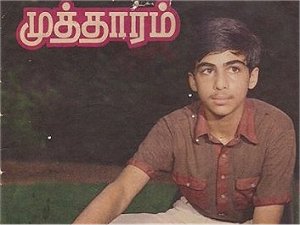Vishy Anand: A Passionate Portrait – Part 2
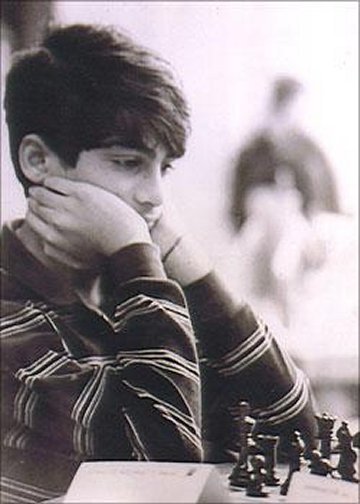
Early Middlegame: The first breakthrough
Bombay, 1983
It was a sultry May afternoon at the Indian Institute of Technology campus. The National Team Chess Championship was in progress and one of the boards had many spectators crammed around it, trying to take a glimpse of the unfolding drama as one of the players was in time pressure. The conditions were sweaty yet a 13-year-old boy sat there wrapped in blankets and woollen clothes, with his mother sitting beside him. He was down with fever but had insisted on playing for his team - the Madras Colts.
Facing him was IM Manual Aaron, a 9-time National champion and an Indian legend who had beaten the likes of Euwe and Portisch. The boy had managed to hoodwink him once before but this time he was determined. However, the position did not favour Aaron. He tried to think of a way to survive, consuming a lot of time in the process. He made his move.
Thud! Thud! It was his move again.
A visibly shocked Aaron offered his hand in resignation. His opponent had taken a mere thirty minutes to play all his moves - the Lightning Kid.
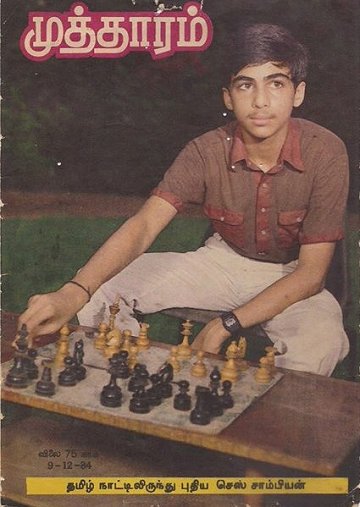
Guess the opening on the board (and what is written here in Tamil!)
1982-83: India takes notice...
Indian Chess in the 1980s was still an old man’s game. People weren’t yet used to losing to 14-year old children who barely thought over a move. This is in contrast to what we see these days when we see 10-year old kids hunting down grandmasters. Probably this is because the times are changing and computers have been getting better and better.
As a newborn child grows in age, its incorruptibility withers away and with time it does not remain that straightforward anymore. Nevertheless, in those good old days, chess was still a toddler with its innocence intact. It was still pure, unblemished by the mechanical abilities of the engines with soulless names. Add to this the fact that India was relatively backwoods for chess activities. Anand’s genius began opening up like a young Lotus readying for its first bloom, in Indian backwaters.
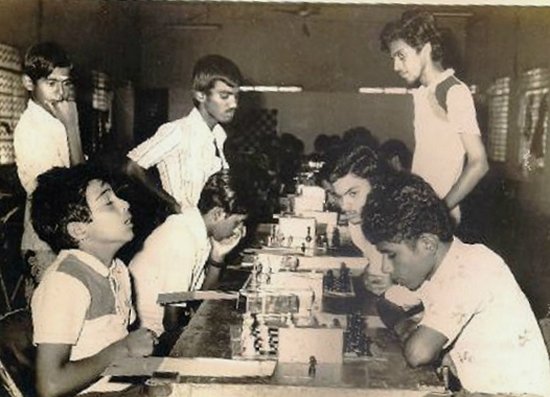
Vishy (about to sneeze?) playing the Tamil Nadu Junior Championship 1982
The years 1982-83 saw the emergence of Vishy as a formidable force. He first won the Tamil Nadu State Junior Championship and finished fifth at the National Sub Junior Championship the same year. Luckily for our boy, there were a set of talented children a few years his senior who were as good as him. In May 1983, the Madras District Chess Association (MDCA) took an imaginative decision of fielding a special team of teenagers in the National Team Chess Championship, 1983 in Bombay. Their intention was to provide these youngsters with valuable experience as all the big guns – as big as they could be - of Indian Chess were to be present there. However, the problem was that the Association needed funds.
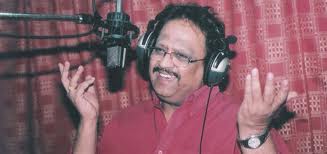
Singer SP Balasubramaniam to the rescue
Dr. Arudra, a noted Telugu writer and then President of MDCA, got the famous Indian film playback singer and music director SP Balasubramaniam to sponsor the Madras Colts Team to the tournament. Playing on the first board, Anand did not disappoint. He scored 3.5/4 - including the win over Manual Aaron - and won the board prize for best performance at the top board thus picking a qualifying spot for the National ‘B’ Championship, 1983.
Soon after the team championship had finished, Anand and his mother went straight to Ahmedabad to play the National ‘B’. This tournament is supposed to be an entry-level test for the players wishing to play the premier National championship of India – the National ‘A’. Although it was Anand's first attempt to pick a qualification spot, he played like a seasoned veteran finishing fourth and easily qualifying for the prestigious National ‘A’ Championship.

1983: Little Anand receiving his prize
The 1983 U16-Championship of India was a formality for the stalwart in a teenager’s disguise as he polished the clueless field 9.0/9. He qualified to represent India at the U16 World Championship in France, 1984. His performance in the senior level went up a notch in the second half of 1983 when Anand won two major open tournaments in his home state despite the presence of higher rated International Masters. He won the Indian Bank open in Madras while at another Tamil Nadu town, called Sivakasi, he won the Rathina Nadar Memorial Tournament.
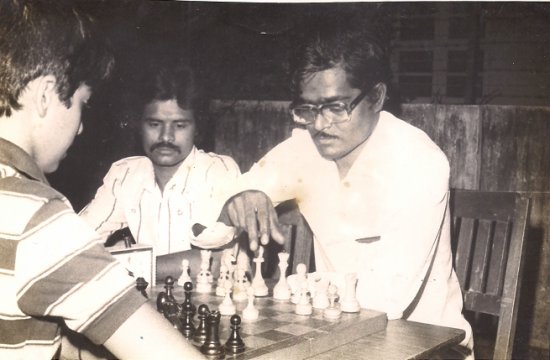
Anand playing at the Indian Bank Open
The cub steps out of its den...
The Tiger, a majestic beast, is India’s national animal. It is only apt that Anand came to be known as the Tiger from Madras, a national pride. But these were early days in his career. The cub made its debut in India’s FIDE rating list in January 1984.
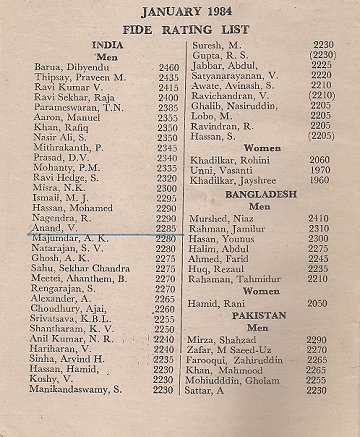
In the same month, Anand played his first National ‘A’ Championship that was held in the same city of Ahmedabad where he had played his National ‘B’. As usual, he managed to surprise the seniors with his natural speed and strength finishing fourth overall.
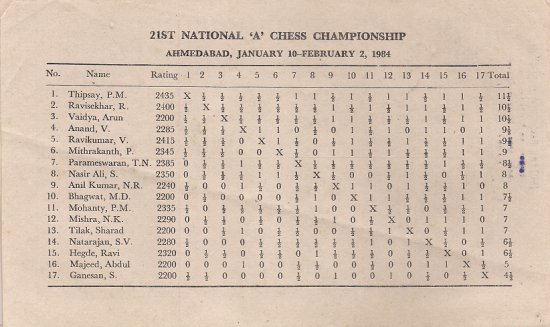
Not one to rest on his laurels, Anand immediately left for Vasco da Gama, Goa, to play the National Junior (U19) Championship. Although he was shocked in the third round, he managed to make mince meat of the remaining opponents to take clear first place.
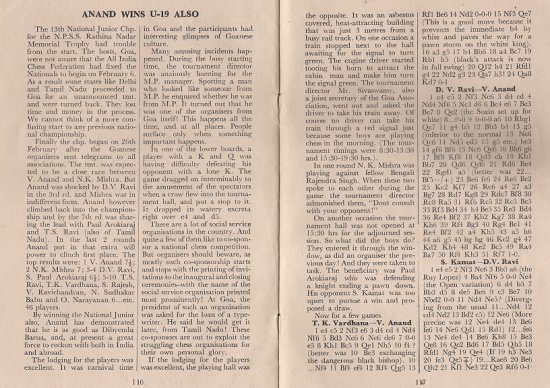
A report from the Indian magazine Chessmate. Read and have a laugh.
You will not find the following games in databases. A little keepsake if you are an Anand fan.
When the going gets tough, the tiger gets going...
Due to his victory at the National U16 Junior Championship a year before, Anand went to Nice, France, accompanied by his parents to compete in the World U16-Championship. Once he reached France, it came to light that he had caught jaundice. This time around, his parents were not allowed into the tournament hall. However, the arbiters were kind enough to assure them that he will be taken good care of.
On many occasions, a sick Vishy would make a move and doze off. It was at this tournament, watching their son play against all odds, that Susheela Vishwanathan and K. Vishwanathan realised how deeply he loved chess. He tied for second place with Vasily Ivanchuk and took bronze on tie-break while Alexey Dreev took first. Nevertheless, they didn’t have any inkling that they were witnessing the making of a World Champion.
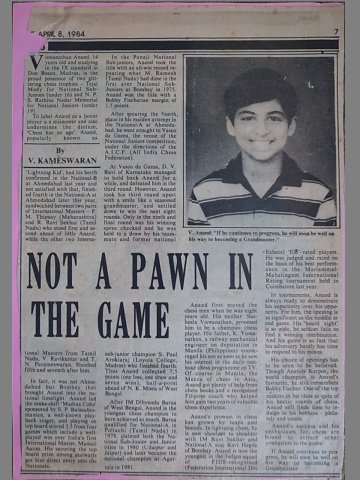
April 1984
His first World Juniors
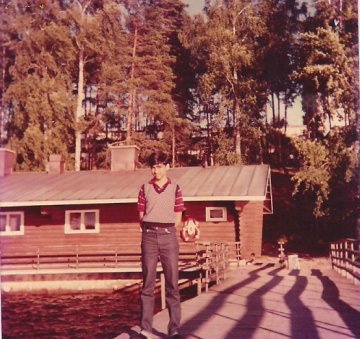
Vishy in Finland
Soon after the U16 success, Anand went to Kiljava, Finland to participate in the World Junior Championship. This tournament still is a prestigious event because many of its winners went on to become top class players or even World Champions. Anand had a sedate tournament scoring 7.5/13 to finish tenth.

Vishy Anand plays with White against German Jörg Hickl
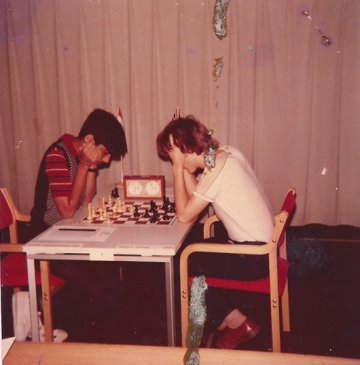
Playing against British Junior Champion Peter Wells
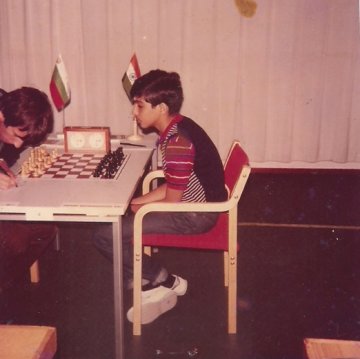
Facing defending champion Kiril Georgiev of Bulgaria.
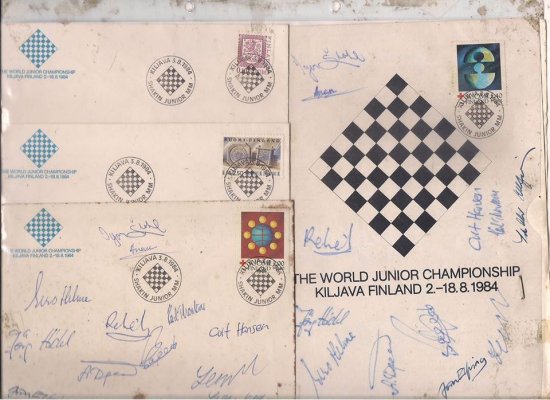
Can anybody recognise these signatures?!
The English Opening...
In 1984, Anand made his first trip to England to play in the Lloyds Bank Open and Junior tournament. He immediately grabbed the attention of the British chess media as soon after his arrival he finished second to then IM Mark Hebden in a Rapidplay championship.
Anand won the Lloyds Bank Junior Invitational tournament which created a minor flutter – he was only the second Indian after the legendary Mir Sultan Khan to win a tournament in London. In 1985, he even managed to win it for the second time!
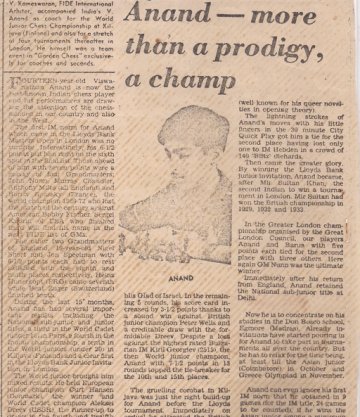
In the Lloyds Bank Open which followed, he finished half a point behind former World Champion Boris Spassky and four others, and scored his first IM norm.
In the Greater London Championship, after the Lloyds Bank Open, he tied for second place behind John Nunn.
Asian Junior Chamionships, 1984 and 1985: The tiger slayer next door
Vajira Perera of Sri Lanka was apprehensive of playing the Asian Junior Championship at Coimbatore, Tamil Nadu - he was playing the tournament disguised as a Fijian - because of the anti-Lankan sentiments that prevailed there in the 1980s. This, however, did not affect his play as he raced away to share the lead with Anand, both tied at 3.0/3.
When he beat Anand in round four Perera had good chances to win the tournament.
This game came as a jolt to young Anand and the Indian chess fraternity. Perera continued his winning streak to reach a towering 6.0/6 while Anand trailed a point behind. The tournament went over 9 rounds and the rules dictated that in case of a tie, the result of the direct encounter was considered above everything else; thus Perera was effectively leading by 1.5 points! But then Perera blundered. In the 7th round, Anand was held to a draw by an Australian player. Seeing this Perera, who had a completely winning position, offered a draw to his opponent from Bangladesh! Lightning struck in the next round as he lost while Anand took his chances to win. In the final round, Perera – needing a win to clinch the title - was two pawns up, but could only draw the game while Anand won comfortably to become Asian Junior Champion for the first time.
Normally the winner of this tournament straight away became an IM, but because less than 14 players took part in the tournament Anand was only awarded an IM norm for this victory.
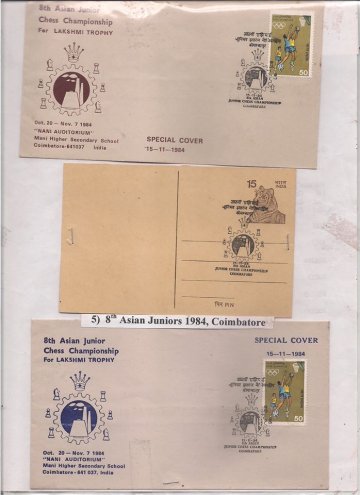
Post card and envelopes commemorating the Asian Juniors 1984
In the 1985 edition of the Asian Juniors at Hong Kong, Perera was again pitted against Anand. Uncharacteristic of his style, Anand played the French Defence and was duly pummelled. The position was a rare sight to behold. Anand simply does not lose like that. This game never entered the databases, however, here it is:
Nevertheless, Perera's win once again proved insufficient to derail Anand who ploughed through the field to score 8.5/11 becoming - at 15 years of age - India’s youngest International Master.
Many chess players tend to retire from competitive chess when they start working in their profession or begin to study. Vajira Perera had to leave chess due to the lack of tournaments in his country which was suffering from civil unrest in the 1980s. Anand stayed, and as everybody knows, changed Indian chess forever. Becoming a grandmaster - especially in those days – was tough and India had none. The 15-year old Anand set out to fulfil his responsibility.
(More about that in Part 3 that will follow soon...)
Fun question: Spot Vishy Anand!
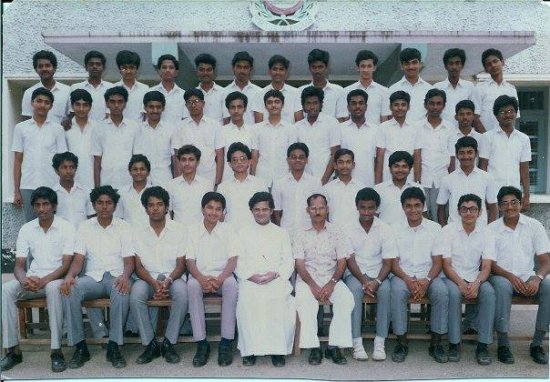
Don Bosco pupils
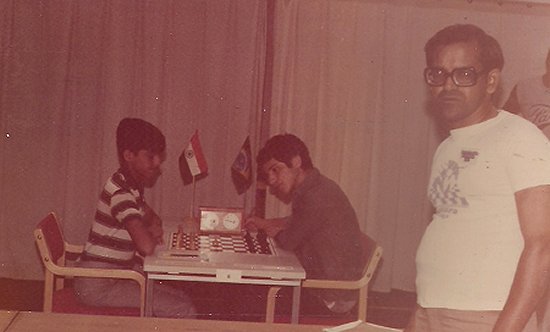
IA V. Kameshwaran
Special thanks to IA V. Kameshwaran for sharing the valuable pictures and newspaper cuttings. Mr. Kameshwaran is the first International Arbiter from India and has acted as the official coach for young Indian players in their tours abroad. He is also a renowned chess journalist.
Bibliography:
- Old Chess Mate magazines. One of the best sources of Chess news in India.
- Vishy Anand Interviews at rediff.com, 2000.
- Saturday Extra, Tribune Magazine, October 16, 2004.
- Anand on World Championships: From Square one to World Championships in Bonn, Chessbase, 2009.
